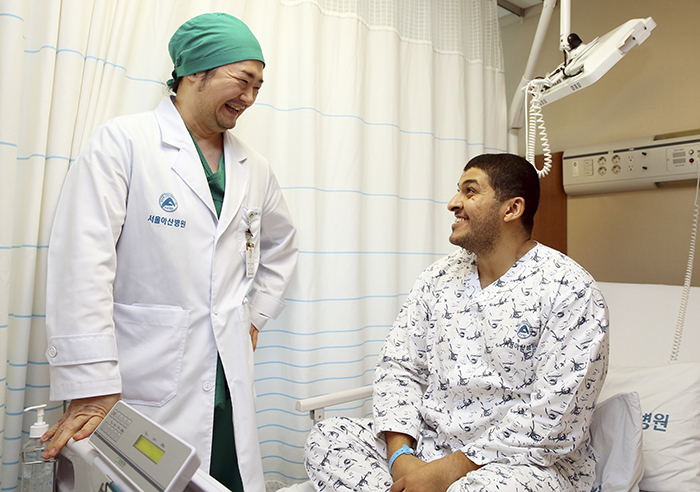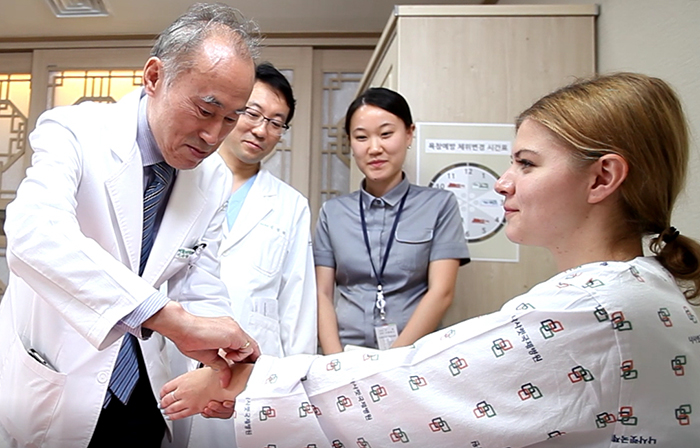월드비전
“Thank you, Korean doctors”
관리자2
0
5,055
2018.11.01 11:11
“Thank you, Korean doctors”

An Egyptian surgeon, Shanann Mohamed, with multiple liver tumors listens to Professor Kim Ki-hun’s instructions after receiving laparoscopic surgery for a hepatocellular carcinoma. (Asan Medical Center)
By Xu Aiying and Kim Min-Jeung
Case #1 Surgeon Shanann Mohamed, 30-years-old and from Egypt, had multiple tumors in his liver. He recently received laparoscopic surgery for the hepatocellular carcinoma at a Korean hospital in July. Neither equipment nor surgeons for a laparoscopic surgery were available in Egypt. After the surgery, Shanann was left only with a small scar and was able to avoid any complications.
Shanann, who came to Korea for the first time to receive medical treatment, said, “I was worried about the culture, which is totally different from Egypt, but the hospital took care to provide Muslim patients with halal food and a prayer room so I could concentrate on getting better.”
Case #2 Aung Sumon, also 30-years-old and from Myanmar, couldn’t chew food properly due to a facial asymmetry resulting from a slight misalignment of the teeth, called a malocclusion. However, he recovered after receiving post-calibration treatment at a Korean hospital in April, which greatly cut down the amount of time required to recover.
Sumon said, “I used to lack confidence when meeting people because of my deformed face, but after a month in Korea, now I feel reborn. I was amazed by the art of Korean medicine.”
What these two people share in common is that they are both medical tourists who visited Korean hospitals. While staying in Korea, they were able to enjoy some tourism, recreation, leisure and cultural, depending on their health status, all while receiving one-stop service that comprised of airport pickup and sendoff, accommodations, and translation services.

A non-Korea patient receives a Korean therapy treatment at the Nasaret International Hospital. (Incheon Tourism Organization)
According to the Ministry of Health and Welfare, medical tourists to Korea have increased five-fold since 2009 when the government started allowing hospitals to seek out foreign patients. Areas of medical treatment, too, expanded from simply plastic surgery and dermatology to now include overall health check-ups, treatment for severe diseases, traditional Korean medicine treatments, and "wellness,” too, meaning just general treatment for one’s well-being and fitness.
Non-Korean patients all say that the high quality medical technology here is one of the biggest merits.
Shanann, the patient from Egypt, said, “The fact that I came to Korea being a surgeon myself means that I have a lot of faith in the medical technology available at Korean hospitals today. Doctors here performed the difficult surgery just about perfectly.”
Medical costs that are relatively cheap here, compared to the high-quality of medical technology, also add up to the merits of seeking out medical services in Korea.
Samuel Green, 41-years-old from the U.S., said, “The U.S. doesn’t provide cancer insurance or eye care insurance, in addition to medical insurance. I chose to come to Korea, aside from other nations, for the affordable costs.”
The Korean government has continuously worked to cultivate its medical tourism industry.
The quality of medical service has greatly improved across the country. Medical tourism visas, The Korean Accreditation Program for Hospitals Serving Foreign Patients (KAHF), registration for foreign patients at medical institutions, and the obligation to sign up for medical liability insurance have all helped the industry to grow.
Due to an aging population worldwide and due to the development of medical technology, the medical tourism industry is expected to grow. Joo Sung Hee, head of the Medical and Wellness Team at the Korea Tourism Organization, said, “Korea is emerging in the medical tourism industry with its excellent medical staff, systems and technology. Once a specialized strategy is properly set up, the medical industry will serve as an attractive field to non-Koreans.”
